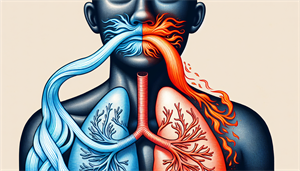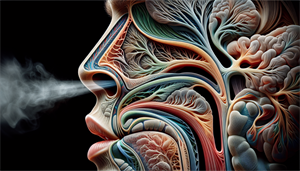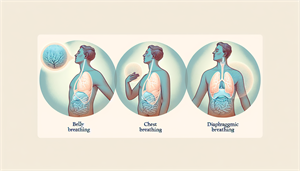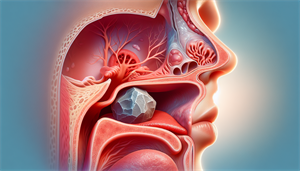When it comes to the mouth vs nose breather debate, the stakes are higher than you might think. This isn’t about simple preferences — it’s about your health.
We’ll explore the nuances of each breathing mode, their effects on your well-being, and practical steps towards optimal breathing.
Dive in to make an informed decision about the best way to breathe for your body.
Key Takeaways
-
Chronic mouth breathing can lead to developmental changes in children, facial structural issues, dental problems, and sleep apnea in adults, as it bypasses the nasal pathway’s filtration and humidification process, making it less optimal than nose breathing.
-
Nose breathing is associated with multiple health benefits, including improved oxygen circulation due to nitric oxide production, better lung function, and superior infection resistance, making it the preferred respiratory method.
-
Breathing exercises and addressing underlying conditions like allergies or deviated septum can facilitate the transition from mouth to nose breathing, which can enhance overall respiratory health, exercise performance, and sleep quality.
Understanding Breathing: Mouth vs Nose

The breath of life flows through two primary channels: the mouth and the nose. Each pathway offers a different respiratory experience, but is one superior to the other? When people breathe, they may not give a second thought to the route air takes before filling their lungs. Yet, this simple choice between nasal or oral breathing can have significant implications for overall well-being.
The Mechanics of Mouth Breathing

Mouth breathing might seem like an innocuous act, but it’s akin to leaving the door wide open, inviting a host of unwelcome guests. Chronic mouth breathing can lead to:
-
Reshaping a child’s development
-
Gaunt facial structure
-
Dental issues
-
Casting a long shadow over their future health.
Mouth breathing adults aren’t spared either; the list of potential ailments stemming from this habit includes sleep apnea, gum disease, and a parched oral environment ripe for decay. What’s more, the very structure of our faces and medical conditions like sinusitis can nudge us unwittingly towards mouth breathing, exacerbating these problems.
The Science Behind Nose Breathing
Imagine a breath that not only sustains but also enhances life. Nose breathing does just that, with each inhale enhancing blood flow and oxygen circulation thanks to the magic molecule, nitric oxide. The lungs revel in improved function, warding off infections more robustly as they receive air that’s been optimally filtered, warmed, and humidified by the nasal passages.
The nose serves as a vigilant sentry, its hairs and mucus trapping harmful invaders that mouth breathing cannot catch.
Comparing Respiratory Effects
The act of breathing through your nose is not just about filling the lungs; it’s a symphony of respiratory muscles working in concert to draw in more oxygen with less effort. The reduced respiratory rate of nose breathers speaks to the efficiency of this natural filtration system, contributing to improved respiratory function.
Even during the physical strain of exercise, nose breathing outperforms mouth breathing, delivering more life-sustaining oxygen to taxed tissues.
Recognizing Breathing Patterns

The red flags of chronic mouth breathing are often mistaken for harmless quirks or temporary discomforts. Yet, they’re indicators of a deeper malaise, one that can compromise dental health and shape the contours of the face. From the telltale signs of dry lips and snoring to the struggles with sleep apnea and persistent bad breath, these symptoms hint at a reliance on oral breathing that may have taken root in childhood, setting the stage for long-term respiratory and health challenges.
Indicators of Chronic Mouth Breathing
Bad breath and chapped lips are not merely inconveniences; they are the whispers of a chronic mouth breather, signaling a body in distress. Nighttime brings its own set of clues, with the dry mouth and the pillow’s telltale signs of drool painting a picture of a night spent breathing through an open mouth, inviting dental decay and gum disease.
Nasal Obstruction and Its Role

Sometimes, the choice between nose and mouth breathing isn’t a choice at all. Nasal obstructions, like a deviated septum or small nostrils, can force air down the less optimal path of mouth breathing. Addressing such physical impediments can be a breath of fresh air, literally, paving the way back to the health benefits of nasal breathing.
Transitioning to Healthier Breathing
For those accustomed to breathing through their mouth, the journey back to nasal breathing is not just beneficial; it’s transformative. Breathing exercises can serve as a gentle guide, retraining the body’s respiratory patterns away from the mouth and towards the health-giving nose.
But it’s not just about breathing differently; it’s about embracing lifestyle changes and relaxation techniques that pave the way for better habits and stop mouth breathing in its tracks.
Techniques to Encourage Nose Breathing
Learning to harness the diaphragm, the chief muscle in the breathing process, is crucial for shifting from mouth to nose breathing. Diaphragmatic or belly breathing requires mindfulness, but it’s simple: a slow inhale through the nose to raise the abdomen, followed by a controlled exhale through pursed lips while the belly withdraws.
Those seeking equilibrium might find solace in alternate nostril breathing, a practice that not only improves lung function but also instills a sense of calm.
Addressing Underlying Causes
Mouth breathing, especially when it begins in childhood, can lead to a cascade of health issues, from stunted growth to dental and facial anomalies. Inhaling through the nose offers a protective barrier, filtering and humidifying the air for respiratory health, and producing nitric oxide that bolsters cardiovascular and immune systems.
Common causes like allergies, a deviated septum, or sleep apnea, must be addressed, sometimes requiring medical interventions such as surgery to clear the way for healthy, unobstructed nose breathing.
Enhancing Breath Control and Efficiency
Taking control of your breath is akin to mastering the wind; it’s a powerful force that can elevate well-being to new heights. Advanced breathing exercises like:
-
Diaphragmatic breathing, which strengthen the respiratory muscles
-
Alternate nostril breathing, which balances the flow of energy in the body
-
Deep breaths, which help to calm the mind and reduce stress
-
Box breathing, which also aids in stress reduction
These exercises can significantly boost lung capacity.
Moreover, practices like the Breath of Fire invigorate the lungs with a fiery power, enhancing respiratory efficiency.
Alternate Nostril Breathing

Alternate nostril breathing, a gem from the treasure trove of yogic practices, offers a unique approach to respiratory health. Regular engagement with this technique harmonizes the nervous system, reduces stress, and even balances brain hemispheres.
Ten minutes of this practice can activate the body’s natural healing response, offering a deep sense of relaxation and restoration.
The Power of Diaphragmatic Amplitude
The diaphragm’s dance is a critical element in the circulatory symphony, moving oxygen throughout the body with grace and efficiency. Not only does diaphragmatic breathing alleviate stress on the cardiovascular system, it proves its mettle in the heat of intense exercise without sacrificing power output.
The Impact of Breathing on Exercise and Sleep
The way we breathe can influence our ability to push our bodies to their limits and the depth of our slumber. Mouth breathing often leads to faster fatigue and a feeling of breathlessness, while nose breathing during exercise keeps the heart rate in check and improves oxygenation, potentially enhancing athletic performance.
At night, mouth breathing can disrupt sleep, leading to airway dryness and sleep disorders such as snoring and obstructive sleep apnea.
Breathing and Physical Activity
Runners who master the art of nose breathing enjoy a lower respiratory rate and a more harmonious balance of oxygen and carbon dioxide, highlighting the efficiency of nasal over oral breathing. Engaging in nose breathing during exercise not only reduces the need to catch one’s breath but also diminishes the perceived difficulty of the activity, allowing athletes to focus on their performance.
Indeed, advanced breathing exercises can fine-tune physiological responses such as heart rate and respiratory frequency, unlocking new levels of sports achievement.
The Only Time When Mouth Breathing is Preferable
Certain situations call for mouth breathing; during high-intensity workouts, it’s the body’s trump card to meet its soaring oxygen demands. Studies reassure us that during such strenuous anaerobic exercise, the mode of breathing does not compromise performance, thus leaving the choice to personal comfort and necessity.
Breathing Through Your Mouth and Sleep Disorders
The nighttime mouth breather unwittingly sets the stage for a restless slumber. In children, this habit is often linked to obstructive sleep apnea, a condition exacerbated by enlarged adenoids or tonsils. A high prevalence of sleep disorders among mouth breathing children underscores the urgency of addressing this issue early on.
Adults, too, may find that a dry mouth upon waking is more than just an annoyance; it’s a red flag for potential sleep-related breathing disorders.
Summary
As we draw this respiratory journey to a close, remember that the path your breath takes matters. Nose breathing emerges as the champion of health, filtering and optimizing the air we breathe, while mouth breathing is reserved for those moments of intense physical demand. The subtle art of breathing through your nose can transform your health, enhancing your physical and mental well-being. Embrace the power of breath, and let each inhale be a step towards a healthier you.
Frequently Asked Questions
Should I be a mouth breather or nose breather?
You should primarily be a nose breather as it provides more oxygen and may help protect you from infections. Mouth breathing may be necessary during a cold, but offers fewer health benefits overall.
How do you fix a mouth breather on your face?
To fix mouth breathing, start by practicing breathing through your nose and using a nasal dilator. Consider myofunctional therapy to strengthen tongue and throat muscles for improved function.
Do mouth breathers get sick more than nose breathers?
Yes, mouth breathers can be more susceptible to getting sick because breathing through the mouth can cause the airways to become irritated and more susceptible to infection. It's important to try to breathe through your nose to reduce this risk.
Can learning to breathe through the nose improve sports performance?
Yes, learning to breathe through the nose can improve sports performance by enhancing oxygen absorption and utilization, lowering respiratory rate, and reducing perceived exertion during physical activity.
Are there any situations where mouth breathing is actually beneficial?
Mouth breathing may be beneficial during high-intensity workouts to meet the body's increased oxygen demands, but nose breathing is generally more advantageous in normal circumstances.


